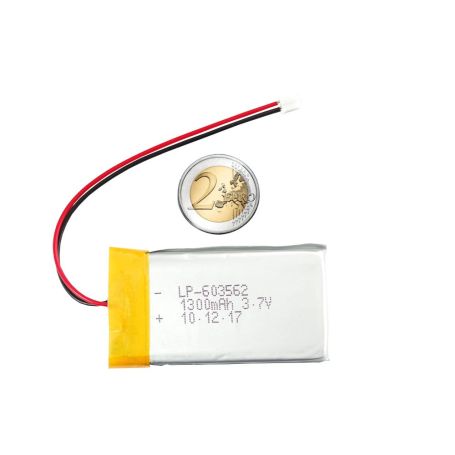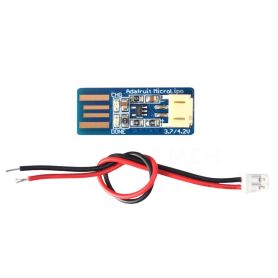Lipo battery - 3.7v 1300mAh
Lithium Ion Polymer battery - 3.7v 1300mAh
Payments are secured by LyraCollect, a French payment collection company.
It is possible to delivered to your home, to a pick-up point or picked up by appointment at MCHobby
We prepare, pack and ship your orders with great respect and care.
A 1300mAh Lipo battery for your mobile project
Lithium Ion Polymer battery (also known as 'lipo' or 'lipoly') are fine, light and powerful. The output voltage is in the range of 4.2V when fully charged to 3.7V. This battery has a capacity of 1300mAh (see 1400mAh according to supply) for a total of about 4.8Wh.
If you need a more powerful battery, there is also a 2500mAh model as well as many other models available in our range.
The battery comes with a 2pins JST-PH connector (see picture) and has the necessary protective circuitry. Thanks to their true JST connector, not a compatible version, the connection/disconnection will be done smoothly and you're protected from cable pulling, problems of correct connection, more or less suitable insertions.
The protective circuitry prevents battery voltage from climbing too high (over-charge) or decreasing too low (over-use/over-discharge) which means that the battery will automatically shut off when it's completely dead and reaches 3.0V voltage. It will also protect the battery against short-circuits. However, even with these protections it is very important to use ONLY a constant current/constant voltage Lilon/LiPoly charger with a charging current of 500mA or less. Example of charger Lilon/LiPoly current-constant/voltage-constant.
Like most LiPo's, this battery is not equipped with an integrated thermistor. This is why it is suggested to charge at max 1/2C (or even less). In our case, the 500mA max is precisely what is possible to obtain from a USB port.
Additional safety note: Do not use a NiMH /NiCad /acid battery charger! Also, do not abuse this type of battery, do not short circuit, twist, crush or break. As with all Lithium Ion Polymer batteries and any type of power source - they should be used by experienced people (experts) who are comfortable with power supplies.
For electronic application only
These batteries are designed for electronic project power and not for motor propulsion. The battery is equipped with a protection circuit that deactivates the battery if its voltage drops below 3V or if the current is too high.
The discharge current of this type of battery is 1C max!
For example: a 500mAh 1C battery could produce a current 1x500mA = 500mA max.
If you need to motorize a project, you have to look for model-making batteries able to deliver several C. Indeed, the start of a motor creates a very important current draw (close to the short-circuit current), so you need a suitable battery.
Some batteries for model-making are able to deliver up to 35C!
For example: a 2500mAh 35C battery could produce a current 35x2500mA = 87500mA = 87.5A without flinching! What ensure the start of any type of motor.
Be careful however, these batteries have no protection and can catch fire if they are not used/loaded/unloaded correctly.
Technical details
- Weight: 25g
- Size: 33.5mm x 50.5 mm x 8mm
- Output: 1300mAh/1400mAh a 3.7V (nominal voltage)
- Technical data sheet
Tutorials
- Recommended reading: our product sheet on the 5000mAh battery also contains very interesting information on the charging time and the precautions to take with the Lipo batteries.
- All about rechargeable batteries (MCHobby, French)
- All about batteries (MCHobby, French)
- Use a DC-DC controller to power projects (MCHobby, French)
- All about Lithium Ion/Lithium Polymer batteries (AdaFruit , English)






